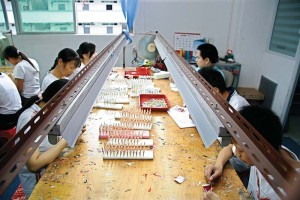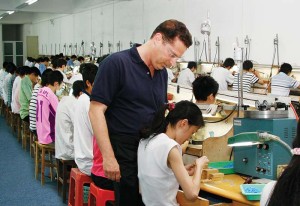Why higher-priced Chinese-made goods may be heading our way
by charlene_voisin | August 1, 2013 9:00 am
By Steven Greenwald
 [1]
[1]
According to the International Monetary Fund (IMF), China has the world’s fastest growing major economy at a rate averaging 10 per cent over the last 30 years. This statistic can be attributed to its large and inexpensive labour force, as well as its political system. In addition to investing heavily in growth and supporting technical development, the government is also quick to make decisions. As such, China can adjust swiftly to changes in the marketplace.
Its growth rate and other factors, such as the global recession, have not only affected the local economy there, but also those of developed countries like Canada, where importers largely rely on China for its low cost of labour. The lure of inexpensive labour proved an interesting opportunity to provide the Canadian jewellery industry with price-point conscious products. So in 2008, my wife opened a manufacturing facility of silver jewellery in a northern suburb of Shenzhen.
Foreign appeal
 [2]
[2]China’s economic policies took a new turn about 30 years ago when it established a Special Economic Zone (SEZ) in Shenzhen. The government’s plan was to create a free market society by legalizing the development of private enterprises with the primary purpose of exporting goods abroad.
At that time, there was an excessive labour force willing to work for low wages. Foreign companies, especially those in Europe and North America, saw it as an opportunity to decrease their manufacturing and labour costs. This was especially beneficial to the jewellery industry, which is labour-intensive.
Chinese entrepreneurs began to open jewellery factories to cater to foreign markets. Growing orders and investments from overseas resulted in a boom in China’s jewellery manufacturing industry. By 2000, numerous foreign jewellery companies had closed their manufacturing facilities at home and shifted their operations to China.
Money started to flow to factory owners, while workers, seeing the new wealth, began demanding better working conditions and wages. The government introduced labour reforms as a way to redistribute the wealth and to ensure workers’ rights. This resulted in higher pay and less working hours. In addition, inflation was on the rise, rents were going up, and the cost of raw materials was increasing, all while China’s currency was quickly appreciating.
As a result, profits among jewellery manufacturers began to erode, although many factories were still able to survive due to the large volume of orders. However, in 2008, the global financial crisis hit, impacting not only luxury jewellery sales, but manufacturing. Factory orders diminished and remaining profits slowly evaporated.
Soon enough, owners cut costs by laying off workers and downsizing their factories, although some opted to move farther inland, where labour and rent were less than half the price of coastal regions. Some factories turned to part-time labour or even outsourced production into people’s homes. Others, however, could not handle the market downturn and cut their losses by simply closing their doors. I have seen one factory converted into a hotel and another into a supermarket.
Our silver jewellery factory was no exception. We saw steady growth in the business for the first few years and then the volume of orders began declining, forcing us to reduce the size of our operation by one third and laying off some staff. This year, we are moving our factory to Sihui, a smaller city a few hours north of Shenzhen. There, rent and labour costs will be cut in half.
During the global recession, China was experiencing rapid economic growth in other areas of its economy, due to its foreign direct investment (FDI) initiative. This created more highly skilled jobs and linked the Chinese economy to international markets. Low-wage labourers evolved into middle class, with a growing appetite for foreign goods and increased spending power.
A new way of doing business
 [3]
[3]With a population of more than 1.3 billion people, China’s market potential is significant; foreign companies are continually trying to find ways to sell their products there. For many jewellery factories in China, it also means a new way of doing business. They are no longer afraid to raise their prices to cover additional costs when needed. And they are changing their business model from being exclusively export-driven to one that includes domestic growth. By diversifying their markets, they can be better equipped to handle the ups and downs of a turbulent economy.
Today, Chinese consumers are better able to afford jewellery, especially young shoppers, who are willing to pay higher prices for more modern and innovative designs. As such, jewellery factories are now investing in research and development. China has a highly skilled workforce that is developing new computer-assisted design (CAD) programs and machinery, as well as advanced forms of production (e.g. setting stones with a microscope). Updated casting techniques and automation have further reduced labour costs. Design, workmanship, and quality control are all improving at a rapid rate.
As such, Canadians can expect to see new and better products in the bridal, diamond, gold, platinum, and silver categories, along with higher prices. However, this may help eliminate many of the problems concerning lack of quality. In the past, not raising prices meant cutting corners, of which many factories were guilty. In my opinion, I believe Canadians will be willing to pay more for Chinese-made jewellery if design and quality are acceptable. And with the skill and speed Chinese factories possess, other manufacturing centres may find it difficult to compete.
Brand expansion
New Chinese jewellery brands are continually entering the local market. A number of factories I have dealt with have even opened their own retail shops in Chinese malls, combining their export business with local wholesale and retail markets.
I predict in the next few years that Chinese branded jewellery will enter the Canadian market and ‘Made in China’ will be taken seriously. Rather than bringing to mind low-quality goods, the term will reflect top design, meticulous workmanship, and superior-quality jewellery products.
These brands may include Chow Tai Fook, the largest jewellery retailer in the world with 1500 retail outlets in China. Its world revenues are 50 per cent more than that of Tiffany & Co. Others like Luk Fook Holding Co., Chow Sang Sang, and TSL are also poised to make an impact beyond China.
At this point, these brands mainly focus on the Asian market and their jewellery reflects the art and design of that part of the world. However, if they were to branch out into foreign markets, they may decide to incorporate a more Western look in their pieces.
A good example of a Chinese brand doing this now is Qeelin, which has 14 shops—seven in mainland China, four in Hong Kong, and three in Europe. Late last year, French luxury group PPR acquired Qeelin. The brand has a Western esthetic, but also incorporates Chinese charms and symbols into its products.
China has less than 30 years of history manufacturing jewellery for foreign markets. It has experienced the ups and downs of the marketplace and made some mistakes along the way. However, it has survived and is on a learning curve that appears to be heading upward. In the coming years, I predict Canadians will see new innovative designs and high-quality workmanship from jewellery manufactured in China and sold in their local Canadian jewellery store.
Steven Greenwald is owner of Supreme Silver, a Canadian-based wholesale jewellery company located in downtown Toronto, and a partner in Kiki Jewellery Ltd., a manufacturing operation located in China. He has a bachelor of arts from the University of Toronto and graduated in computer science. Soon after, Greenwald developed a passion for jewellery, earning a graduate gemmologist (GG) diploma from the Gemological Institute of America (GIA). He has been in the jewellery business for more than 25 years. Greenwald spends his time travelling between Canada and China, where he lives with his wife and daughter. Greenwald can be contacted via e-mail at steveng@supremesilver.com[4].
- [Image]: http://www.jewellerybusiness.com/wp-content/uploads/2015/12/bigstock-Modern-Shenzhen-City-China-40357255.jpg
- [Image]: http://www.jewellerybusiness.com/wp-content/uploads/2015/12/MG_4011.jpg
- [Image]: http://www.jewellerybusiness.com/wp-content/uploads/2015/12/MG_3996.jpg
- steveng@supremesilver.com: mailto:steveng@supremesilver.com
Source URL: https://www.jewellerybusiness.com/features/why-higher-priced-chinese-made-goods-may-be-heading-our-way/